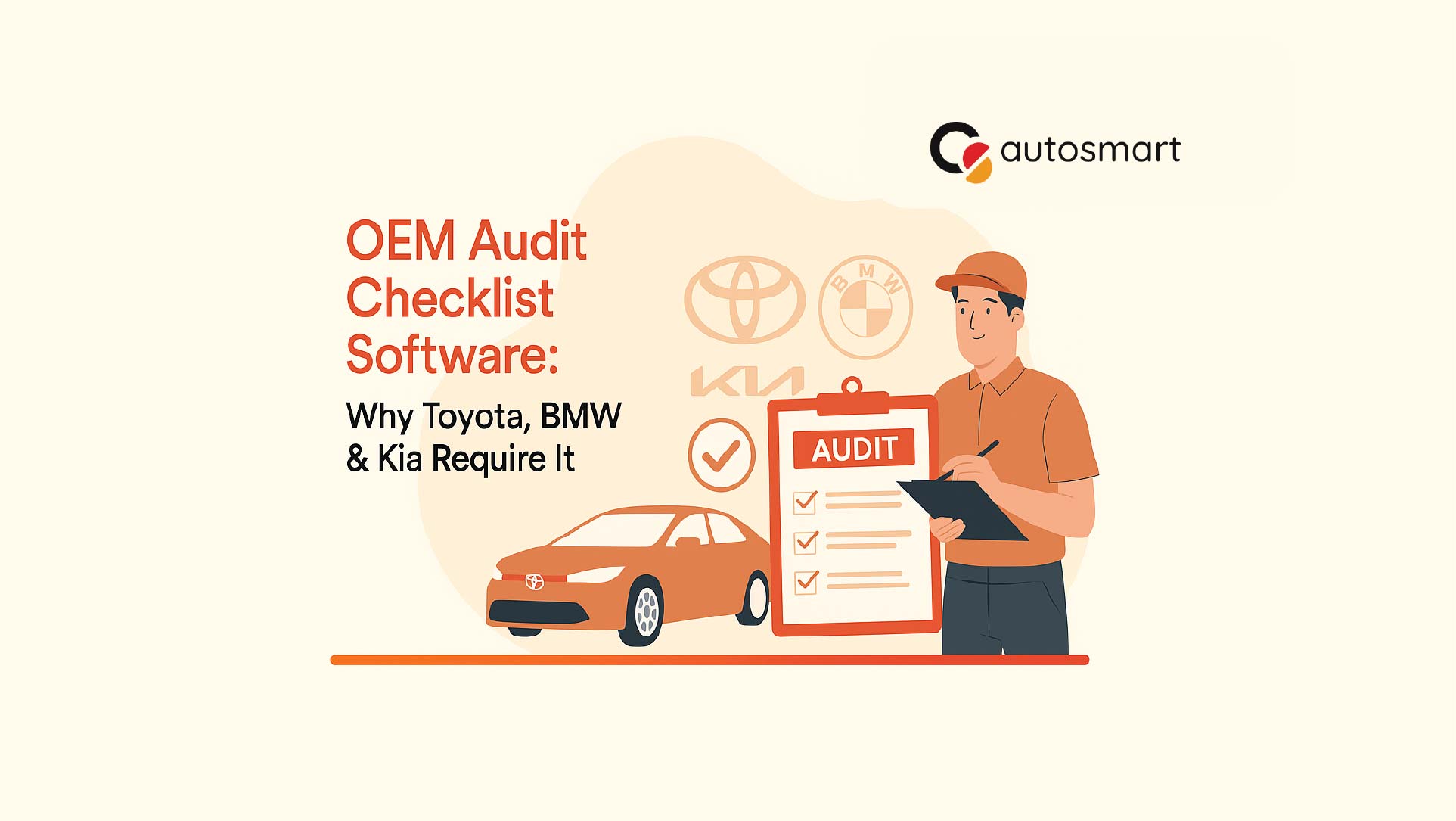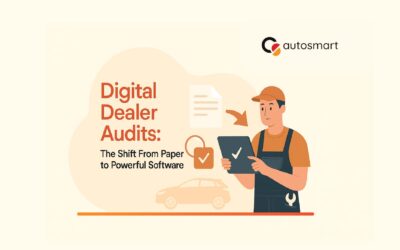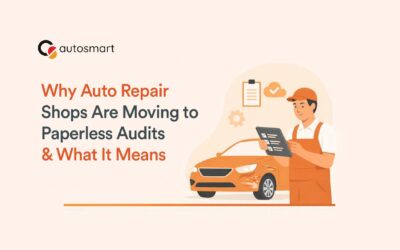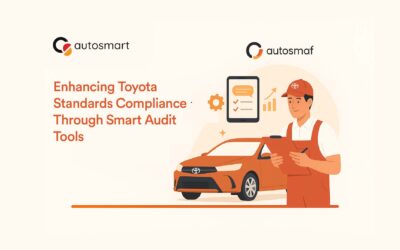The automotive ecosystem includes a plethora of networks between manufacturers, integrators, dealers and OEMs. Precision, brand consistency, and compliance are indispensable constituents of today’s automobile environment, with quality control becoming paramount.
In a remarkably highly regulated and competitive market, OEMs must verify that every product that hits retail follows strict criteria. Audits are critical here for manufacturers selling at retail to maintain an effective retail presence, ensuring that products not only operate as intended but also consistently reflect the brand across all touchpoints.
Leading automotive OEMs like Toyota, Kia and BMW partner with countless dealers across continents. Whether it’s BMW’s retail quality compliance or Kia’s Red Cube audit requirements, maintaining uniformity in quality and merchandising for over a million people around the globe is strenuous.
This is when Autosmart Audit’s OEM audit checklist software becomes crucial. Let’s delve deeper and get a clear picture of OEM audit checklists.
What’s a Digital OEM Audit Checklist Software and Why Do You Need It?
OEM checklist software is an inspection management software, part of our Dealer Audit Management Software. This is clubbed chiefly together with the OEMs’ audit processes. They replace traditional paper-based audit checklists. These are often customizable, differing for each manufacturer. They’re either dropdowns or free text fields.
The OEM audit checklist software is exclusively used in place of manual documentation. Manually auditing any dealership is a tiring and time-consuming procedure. But digital audit checklists allow insights into dealership performance, producing automatic reports. Inspectors can edit the audit at any time, as they do with manual records, offering flexibility. Large brands like Toyota, Kia and BMW, which are some of the largest OEMs distributing spare parts and automobiles to thousands of shops, can benefit from different types of checklists, easing their processes, and ameliorating each step with dealers. For example, Toyota dealer audit standards might not be the same as those of the dealerships. However, once the dealership enters a deal with an OEM, it has to meet the standards set by the manufacturer.
How are These Digital Audit Checklists Useful?
- Improve Accuracy and Reduce Human Errors
These checklists eliminate legibility issues, prevent missed checkpoints, and ensure all steps are mandatory. They can include drop-downs, validations, and automated scoring to maintain consistency across locations and teams.
- Real-Time Data & Instant Reporting
Unlike paper-based audits, which need to be processed and compiled manually, digital audit checklists allow instant analysis. The audit is completed, and reports can be generated and shared with stakeholders immediately.
- Enable Remote Monitoring & Central Visibility
OEMs’, regional heads, inspectors, auditors and compliance managers can access audit results from anywhere. This helps brands oversee performance across dealership or service networks without needing to be physically present at every location.
- Easy Tracking of Corrective Actions
Digital audit checklists allow users to raise non-conformities, assign corrective actions, set deadlines, and track closure status. This makes audits actionable instead of merely observational.
- Integration With BI, ERP & Quality Systems
Digital audits can be linked with inventory systems, CRM, service management tools, or enterprise dashboards. This cross-functional visibility helps organisations take data-driven decisions and identify trends.
- Faster Audits With Built-In Guidance
OEM Audit Checklist Software can include reference images, SOP links, or guidelines helping auditors evaluate standards accurately, even if they’re new to the process.
- Better Compliance & Traceability
Every audit completed digitally is time-stamped, geo-tagged and securely stored, creating a clear, traceable record. This is valuable for regulatory audits, internal governance, and risk management.
Types of OEM Audit Checklists
Autosmart Audits offers multiple templated sample audits, designed to help you create a curated checklist. Before we study the magnitude of how audit checklists help OEMs, we’ll take a look at the types of OEM audit checklists.
Parts Checklist
A spare parts checklist helps manufacturers monitor how dealers handle, store and order original parts. Spare parts management is vital while supplying to multiple dealerships, especially in the case of prominent brands like Toyota, Kia or BMW.
OEMs use it to verify that dealers maintain accurate inventory records, avoid the use of non-genuine or counterfeit components, and follow proper ordering and return procedures. Effective parts audits help reduce warranty claims, prevent parts shortages, and protect the OEM’s brand reputation by ensuring repairs are carried out using approved components.
Health & Safety Compliance Checklist
This type of checklist evaluates the safety protocols inside operational areas, showrooms, and inventories. This might also be a check to see if the auto dealership’s safety protocols align with those of OEMs.
It involves assessments for workplace safety, technician protection and tool handling. OEMs use automotive compliance tools to ensure that service facilities adhere to safety requirements, reduce accidents, and operate within legal limits. It also helps OEMs protect themselves from litigation and underlines their commitment to operational best practices.
Sales Process Audit Checklist
The sales checklist helps OEMs evaluate dealer effectiveness in lead handling, vehicle demonstrations, consultation quality, and conversion follow-ups. It guarantees that sales personnel appropriately represent the company, use ethical selling techniques, and emphasise essential service packages or warranties. This form of audit assists OEMs in improving the efficiency of dealer-level retail operations and aligning with strategic business goals.
Customer Experience Evaluation Checklist
This checklist evaluates the quality of client contacts at dealerships and service facilities, from scheduling appointments to final feedback. It addresses issues including communication transparency, service updates, complaint resolution, and post-service involvement. OEMs utilise it to match the dealership’s consumer journey with brand requirements, maintaining consistency in experience across all touchpoints and boosting long-term loyalty.
Revenue Generation Checklist
The revenue checklist, which focuses on commercial optimisation, assesses how dealerships market OEM-approved accessories, extended warranties, value-added services, and maintenance packs. OEMs utilise it to find additional revenue possibilities without jeopardising consumer confidence. Regular audits with this checklist assist in boosting profitability while reinforcing the value proposition of OEM-certified goods and services.
Body & Paint Quality Checklist
This checklist is primarily used in collision repair and refinishing facilities to assess the quality of body restoration, paint application, and colour matching operations. OEMs include this during audits to ensure that repair facilities meet factory-grade specifications. OEMs safeguard resale value, maintain quality consistency, and provide a smooth customer experience even after an accident.
Quick Service Performance Checklist
A performance checklist is created for quick maintenance operations, evaluates service length, job execution accuracy, and workshop turnaround efficiency. OEMs utilise it to ensure that rapid service offers perform as advertised and minor maintenance jobs are executed quickly. Monitoring these KPIs reduces wait times, increases workshop efficiency, and boosts customer happiness through efficient service delivery.
Why do Toyota, Kia, and BMW require an audit checklist?
Manufacturers like Toyota, Kia, and BMW require audit checklists to ensure that every dealership’s standards audit system consistently meets their high standards for quality, compliance, and customer experience.
OEM Audit Checklist Software helps verify that operations follow OEM-approved procedures, from service delivery and use of genuine spare parts to showroom presentation and staff training. By maintaining uniform performance across all dealer networks, OEMs can protect their brand reputation, reduce operational risks, and ensure regulatory compliance.
For instance, Toyota’s official 160-point inspection checklist can be digitised, saving time.
Ultimately, audit checklists act as a critical control mechanism that helps manufacturers uphold consistency, improve customer satisfaction, and make informed decisions using accurate performance data.
Move Towards Smarter Audit Management Solutions
The future of audits is digital. By switching to OEM Audit Checklist Software, OEMs and dealers can eliminate errors, enhance compliance, and streamline operations.
Along with Dealer Audit Management, we offer other tools like compliance management software, bodyshop audit management software, etc, on our website.
FAQs
Why do OEMs enforce strict dealership audit checklists?
OEMs do that to ensure that the dealership is in line with the brand’s standards of servicing, selling, and customer service.
What software helps dealers comply with Toyota, BMW, and Kia standards?
An audit management software’s OEM audit checklist helps dealers comply with these brands’ standards.
How does an OEM audit system improve retail quality performance?
OEM audit system tracks the dealership’s sales data, service history, quality of service, inventory management and other such metrics to improve retail quality performance.
Can one audit platform manage multiple OEM standards?
Yes, Autosmart Audit’s audit management software can manage multiple OEM standards for numerous retail stores/dealerships.
Disclaimer:
This article is for informative purposes only and does not represent, quote, or reflect any internal policies, proprietary practices, or confidential strategies of Toyota, Kia or BMW or any other OEM.

Naseef Umar is the Founder & CEO of AutoSmart Technology, a SaaS platform digitizing audits for OEMs, distributors, and dealer networks. With prior experience at Toyota (Abdul Latif Jameel) and a background in IT and Industrial Management, he writes about audits, operational discipline, and building SaaS products for enterprise customers across markets.




